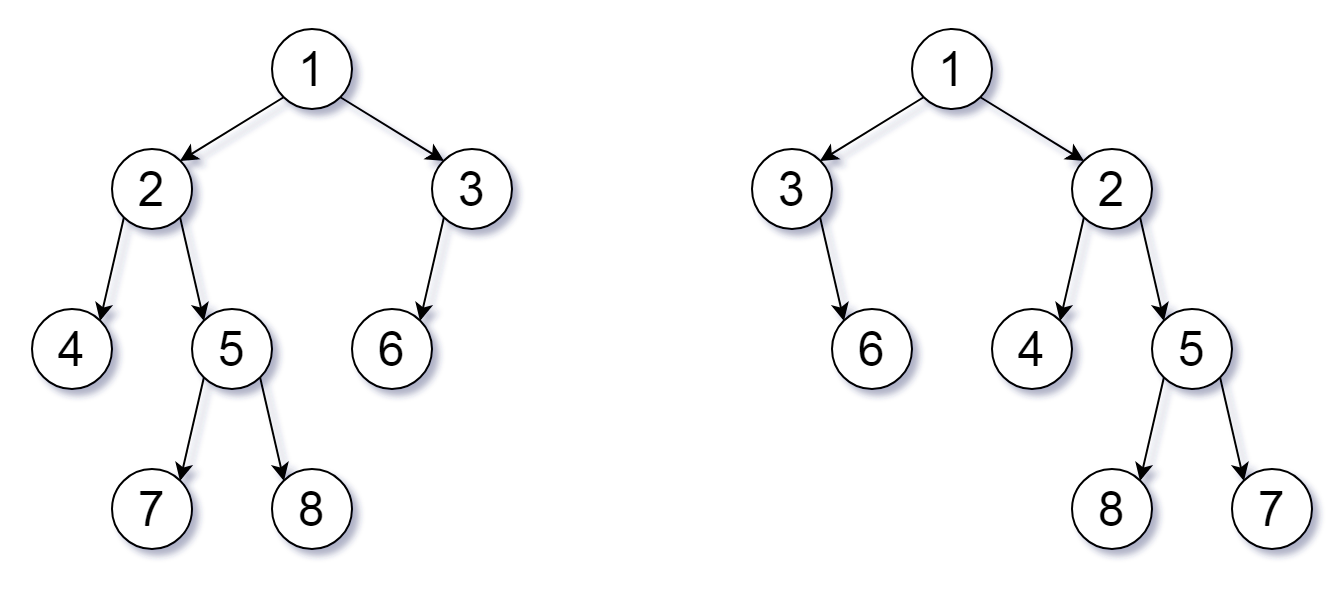https://leetcode.com/problems/flip-equivalent-binary-trees/
For a binary tree T, we can define a flip operation as follows: choose any node, and swap the left and right child subtrees.
A binary tree X is flip equivalent to a binary tree Y if and only if we can make X equal to Y after some number of flip operations.
Given the roots of two binary trees root1 and root2, return true if the two trees are flip equivelent or false otherwise.
Example 1:

Input: root1 = [1,2,3,4,5,6,null,null,null,7,8], root2 = [1,3,2,null,6,4,5,null,null,null,null,8,7] Output: true Explanation: We flipped at nodes with values 1, 3, and 5.
Example 2:
Input: root1 = [], root2 = [] Output: true
Example 3:
Input: root1 = [], root2 = [1] Output: false
Example 4:
Input: root1 = [0,null,1], root2 = [] Output: false
Example 5:
Input: root1 = [0,null,1], root2 = [0,1] Output: true
Constraints:
- The number of nodes in each tree is in the range
[0, 100]. - Each tree will have unique node values in the range
[0, 99].
/**
* Definition for a binary tree node.
* struct TreeNode {
* int val;
* TreeNode *left;
* TreeNode *right;
* TreeNode() : val(0), left(nullptr), right(nullptr) {}
* TreeNode(int x) : val(x), left(nullptr), right(nullptr) {}
* TreeNode(int x, TreeNode *left, TreeNode *right) : val(x), left(left), right(right) {}
* };
*/算法思路:
简单的递归,重点理解思路
class Solution {
public:
bool flipEquiv(TreeNode* root1, TreeNode* root2) {
if (root1 == nullptr && root2 == nullptr) return true;
if (root1 == nullptr || root2 == nullptr) return false;
if (root1->val != root2->val) return false;
bool nonFlip = flipEquiv(root1->left, root2->left)
&& flipEquiv(root1->right, root2->right);
bool flip = flipEquiv(root1->left, root2->right)
&& flipEquiv(root1->right, root2->left);
return nonFlip || flip;
}
};Approach 2: Canonical Traversal
Intuition
Flip each node so that the left child is smaller than the right, and call this the canonical representation. All equivalent trees have exactly one canonical representation.
Algorithm
We can use a depth-first search to compare the canonical representation of each tree. If the traversals are the same, the representations are equal.
When traversing, we should be careful to encode both when we enter or leave a node.
class Solution {
public boolean flipEquiv(TreeNode root1, TreeNode root2) {
List<Integer> vals1 = new ArrayList();
List<Integer> vals2 = new ArrayList();
dfs(root1, vals1);
dfs(root2, vals2);
return vals1.equals(vals2);
}
public void dfs(TreeNode node, List<Integer> vals) {
if (node != null) {
vals.add(node.val);
// unique node values in the range [0, 99]
int L = node.left != null ? node.left.val : -1;
int R = node.right != null ? node.right.val : -1;
if (L < R) {
dfs(node.left, vals);
dfs(node.right, vals);
} else {
dfs(node.right, vals);
dfs(node.left, vals);
}
vals.add(null);
}
}
}






















 8390
8390











 被折叠的 条评论
为什么被折叠?
被折叠的 条评论
为什么被折叠?








